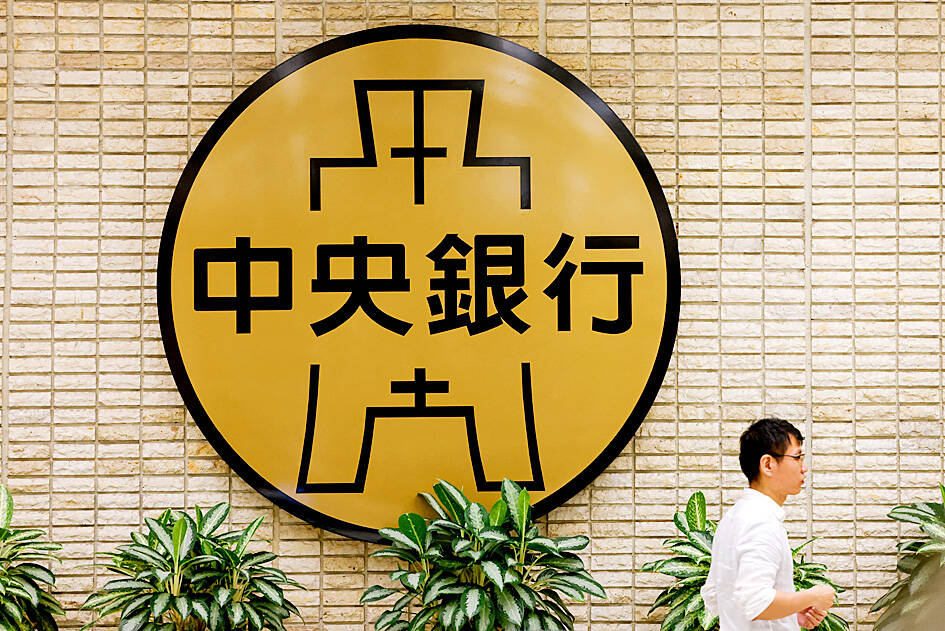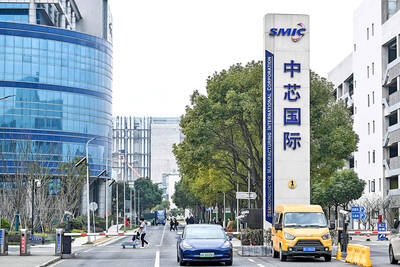The central bank would likely leave its key interest rates unchanged at its quarterly policymaking meeting on Thursday, which should be before the US makes major tariff decisions, Cathay United Bank chief economist Lin Chi-chao (林啟超) said last week.
US President Donald Trump’s chaotic tariff policy rollout has roiled markets and caused significant uncertainty, with goods made in Taiwan and imported into the US still possibly facing a 32 percent “reciprocal” tariff.
Semiconductors, the backbone of Taiwanese exports, could also be hit with even higher import duties if Trump follows through on his threats.

Photo: Ann Wang, Reuters
The global economic situation has become more complicated in the wake of Trump’s tariff policies, Lin said in an interview.
Trump’s 90-day pause on his “reciprocal” tariffs expires early next month, meaning that not only the central bank but also the US Federal Reserve would likely leave their interest rates unchanged before the results are announced.
The impact of the tariffs could become more obvious in the third quarter of this year and is expected to dramatically slow the pace of economic growth in the second half of this year, Lin said.
Taiwan’s GDP grew 5.35 percent in the first half of this year, but would only grow 1 percent in the second half, partly due to tariff concerns, the Directorate-General of Budget, Accounting and Statistics said late last month.
In addition to tariff worries, the central bank is concerned about the appreciation of the New Taiwan dollar against the US dollar, which could affect the profit margins of many Taiwanese exporters, Lin said.
The central bank aggressively intervened in the foreign exchange market last month to slow the pace of the NT dollar’s appreciation against the greenback, but only after the local currency rose by 6.21 percent on May 2 and 3.
The NT dollar remained strong last month, and without the central bank’s intervention, it would have appreciated further against the US dollar, dealers said.
The US dollar’s depreciation is expected to continue amid hopes that the Fed would cut interest rates in September and December to boost the economy, they added.
Under such circumstances, the economy should be the central bank’s top priority, rather than inflationary pressures, Lin said.
Commenting on the NT dollar’s rise, National Central University Research Center for Taiwan Economic Development director Dachrahn Wu (吳大任) said that since the beginning of this year, the local currency has appreciated almost 10 percent against the greenback.
Because of that, companies that are not tech giants with high gross margins, such as Taiwan Semiconductor Manufacturing Co (台積電), could see their bottom lines eroded sharply, Wu said.
Kinpo Group (金寶集團) founder Rock Hsu (許勝雄) on Thursday said that the rapid appreciation of the NT dollar poses a great threat to Taiwanese exporters, urging the central bank to take action to stabilize the currency.
Speaking to reporters at National Taiwan Normal University’s anniversary celebrations, Hsu said Taiwan’s export-driven economy faces stiff external competition and a more favorable exchange rate is needed.
“If the exchange rates fail to support business earnings, it would inevitably undermine firms’ international competitiveness and financing capability, so the central bank has a responsibility to act,” he said.
Regarding the effects of potential US tariffs, Hsu said the levies represent a major “black swan” for Taiwan’s industrial development, but the impact might be limited pending negotiations between governments, compared with the sharp appreciation of the NT dollar.
Additional reporting by Meryl Kao

NO BREAKTHROUGH? More substantial ‘deliverables,’ such as tariff reductions, would likely be saved for a meeting between Trump and Xi later this year, a trade expert said China launched two probes targeting the US semiconductor sector on Saturday ahead of talks between the two nations in Spain this week on trade, national security and the ownership of social media platform TikTok. China’s Ministry of Commerce announced an anti-dumping investigation into certain analog integrated circuits (ICs) imported from the US. The investigation is to target some commodity interface ICs and gate driver ICs, which are commonly made by US companies such as Texas Instruments Inc and ON Semiconductor Corp. The ministry also announced an anti-discrimination probe into US measures against China’s chip sector. US measures such as export curbs and tariffs

The US on Friday penalized two Chinese firms that acquired US chipmaking equipment for China’s top chipmaker, Semiconductor Manufacturing International Corp (SMIC, 中芯國際), including them among 32 entities that were added to the US Department of Commerce’s restricted trade list, a US government posting showed. Twenty-three of the 32 are in China. GMC Semiconductor Technology (Wuxi) Co (吉姆西半導體科技) and Jicun Semiconductor Technology (Shanghai) Co (吉存半導體科技) were placed on the list, formally known as the Entity List, for acquiring equipment for SMIC Northern Integrated Circuit Manufacturing (Beijing) Corp (中芯北方積體電路) and Semiconductor Manufacturing International (Beijing) Corp (中芯北京), the US Federal Register posting said. The

India’s ban of online money-based games could drive addicts to unregulated apps and offshore platforms that pose new financial and social risks, fantasy-sports gaming experts say. Indian Prime Minister Narendra Modi’s government banned real-money online games late last month, citing financial losses and addiction, leading to a shutdown of many apps offering paid fantasy cricket, rummy and poker games. “Many will move to offshore platforms, because of the addictive nature — they will find alternate means to get that dopamine hit,” said Viren Hemrajani, a Mumbai-based fantasy cricket analyst. “It [also] leads to fraud and scams, because everything is now

MORTGAGE WORRIES: About 34% of respondents to a survey said they would approach multiple lenders to pay for a home, while 29.2% said they would ask family for help New housing projects in Taiwan’s six special municipalities, as well as Hsinchu city and county, are projected to total NT$710.65 billion (US$23.61 billion) in the upcoming fall sales season, a record 30 percent decrease from a year earlier, as tighter mortgage rules prompt developers to pull back, property listing platform 591.com (591新建案) said yesterday. The number of projects has also fallen to 312, a more than 20 percent decrease year-on-year, underscoring weakening sentiment and momentum amid lingering policy and financing headwinds. New Taipei City and Taoyuan bucked the downturn in project value, while Taipei, Hsinchu city and county, Taichung, Tainan and Kaohsiung